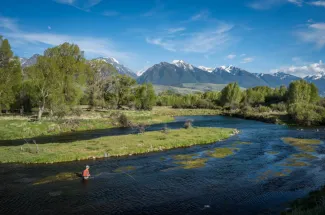The Paradise Valley spring creeks offer some of the most challenging fly fishing conditions for wild trout in the world. These technical fisheries originate from underground aquifers and flow cold and clear year round. The biomass in the spring creeks are astounding and trout densities are extremely high. The combination of abundant food options and gin clear waters produce conditions that require stealth and match the hatch presentation. Many anglers consider spring creek fly fishing to be the ultimate challenge in the sport.
DePuy Spring Creek
DePuy Spring Creek is considered by many to be one of the finest spring creeks on the planet. Its productive waters located in the heart of Paradise Valley draw anglers from far and wide. The creek ranges from 30 to 100 feet wide and has a wide variety of trout habitat including riffles, deep runs, glassy flats and a spring fed pond. Few places on earth can match the picturesque beauty of the DePuy ranch with the Absaroka Mountains towering above a valley filled with deer, swans, cranes and bubbling trout waters.
Armstrong Spring Creek
Located in the heart of Paradise Valley, the scenery located along the spring creek is some of the best in the state. Armstrong originates from a series of underground springs on the O'hair ranch. The portion of the creek on the O'hair ranch is filled with riffles, pockets and runs. The large amount of faster water is often a bonus when fishing a spring creek since the trout have a bit less time to inspect our flies. Fishing on Armstrong is good all year round. The creek is an insect factory and produces an ample supply of mayflies, midges, caddis flies and freshwater crustaceans.



